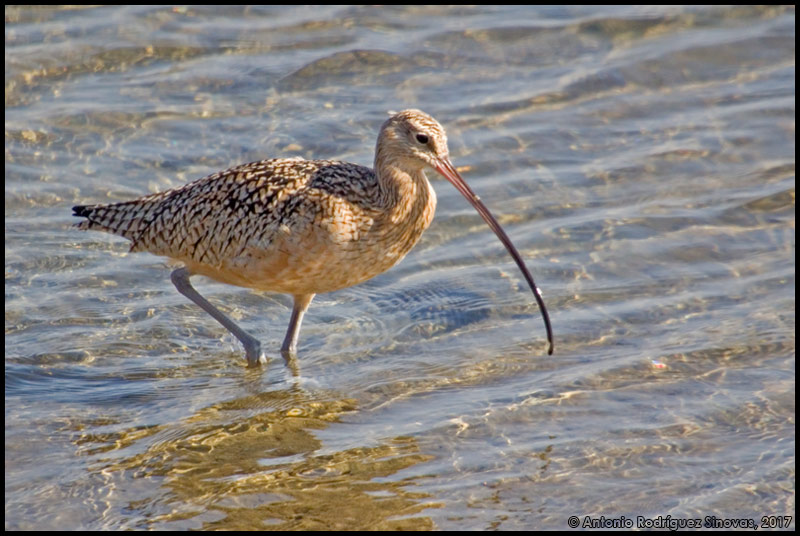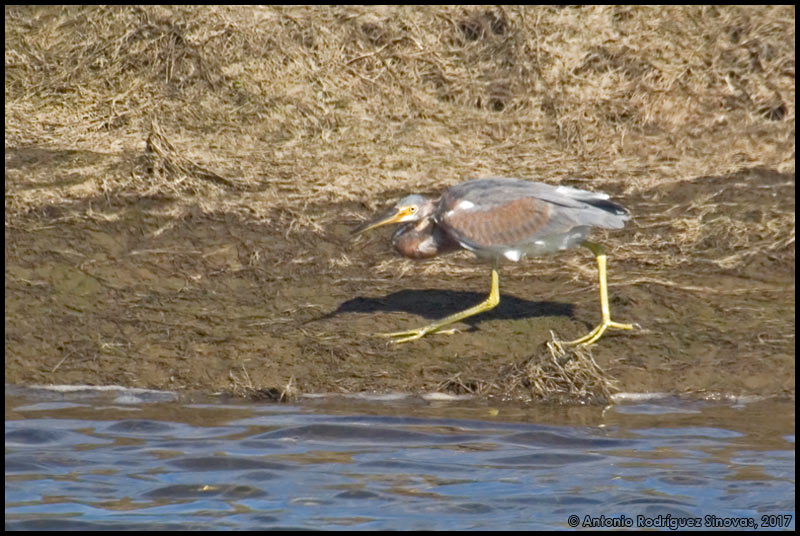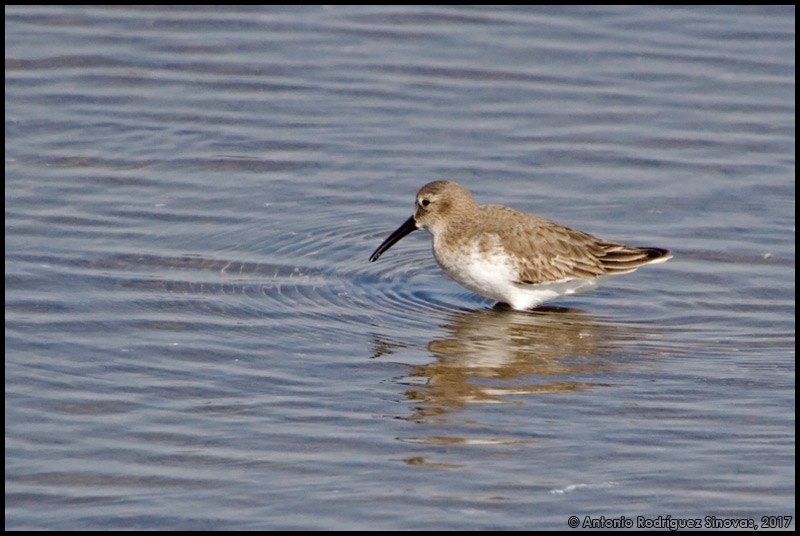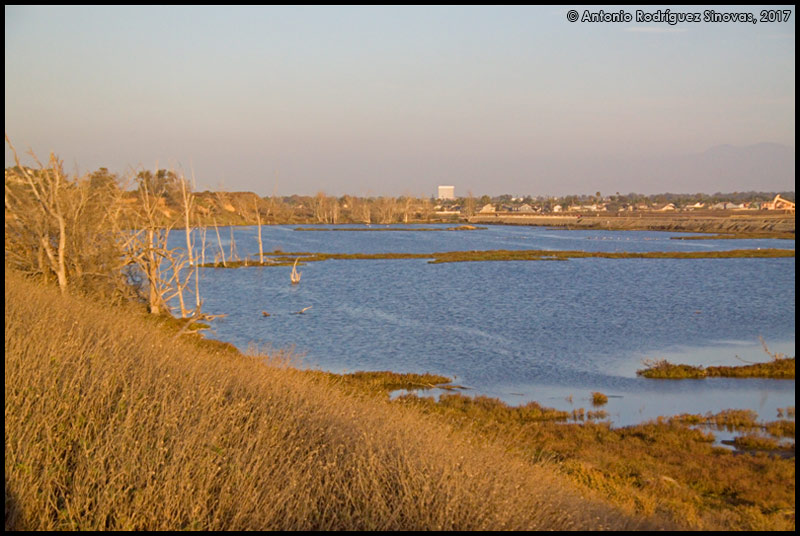Bolsa Chica es un estuario con marismas, aguas abiertas, y una pequeña meseta cubierta de vegetación, y un excelente lugar para la observación de aves en cualquier época del año. Es el hogar del chingolo de Belding, una especie en peligro de extinción, y es un buen sitio para la reproducción de diferentes especies de charranes, incluidos el rayador americano, el charrancito americano, y la pagaza piquirroja, entre otros. Está ubicado en la costa del Condado de Orange, muy cerca de las principales atracciones turísticas de Los Ángeles. Su localización y la lista completa de especies (73) observadas podéis verla en este enlace.
Bolsa Chica is an estuary with saltmarsh, mudflats, and open water, together with an upland mesa, that is an excellent birding spot at any time of year. It is home of the endangered Belding's sparrow, and it became a breeding ground for black skimmers, least terns, caspian and other tern species. It is located in coastal Orange County, very near to the main touristic attractions in Los Angeles. Its location and the complete list of species (73) that I saw there can be found in this link.
La crónica de viaje de eBird, junto con el mapa de las principales zonas visitadas y la lista de aves observadas en el sur del estado de California, puede encontrarse en este enlace.
The eBird trip report, showing a map with the main visited locations, together with the complete list of bird species seen in southern California, can be seen in this link.
Comencé la visita en el pequeño parking situado en la Pacific Coast Highway (South Parking en el mapa adjunto). Nada más cruzar el puente, ya empecé a observar especies interesantes, como achichilique común, malvasía canela, porrón bola y porrón albeola. En la vegetación cercana al parking, algunos paseriformes, como mosquero llanero o cucarachero pantanero.
I began my visit from the small parking lot located at the Pacific Coast Highway (South Parking in the map). When I crossed the footbridge I began to see interesting species, as western grebe, ruddy duck, lesser scaup and bufflehead. In the scrubs around the parking, some passerines, including Say's phoebe and marsh wren.
Tras cruzarlo, y alrededor del punto del mapa denominado "South Overlook", pude darme cuenta de lo importante de este espacio. Tras ver algunos paseriformes, como el camachuelo mejicano o el chingolo sabanero, pude observar cientos de limicolas. Entre ellos agujas canelas, zarapitos americanos, vuelvepiedras cumún, y otras especies como barnacla carinegra, gaviotas occidentales o pelícano norteamericano. Me sorprendió gratamente lo cerca que se dejaban ver. Nada que ver con lo que ocurre en Europa.
Once I crossed the bridge, I arrived to the South Overlook point. Here I realized about the importance of Bolsa Chica. After some passerines, including house finch and savannah sparrow, I began to see thousand of shorebirds, including marbled godwit, long-billed curlew, ruddy turnstone and other species as brent goose, western gull or american white pelican. I was pleasantly surprised about how close birds were. Nothing to do with what happens in Europe.
En la zona de la Rabbit Island, el número de limícolas era impresionante. Hay que añadir a la lista anterior, correlimos menudillo, común, gordo y de Alaska, playeros aliblancos, y agujetas grises. Además, diversas ardeidas, incluyendo garceta rojiza y tricolor, y algunas anátidas, principalmente silbón americano. Hay que decir que tuve suerte con el día, ya que la marea estaba baja, permitiendo la concentración de todas estas especies.
In the area known as Rabbith Island, there was a huge number of shorebirds. Added to the previous list, there was least and western sandpipers, red knots, and dunlins, together with short-billed dowitcher. In addition some egrets and herons, including reddish egret and tricolored heron. Regarding ducks, the main species was the american wigeon. I have to mention that I was lucky with the day, as the the tide was low, leading to a concentration of such species.
Western sandpiper (left) and least sandpiper (right)
(Calidris mauri and C. minutilla)
En el Wintersburg Channel y alrededor estaban la mayoría de anátidas, incluyendo serretas medianas, porrón bola y albeola, cercetas aliazules y porrón americano. También algunos moritos cariblancos, gaviotas de Delaware, charranes de Forster y martines gigantes norteamericanos, entre otras especies.
Ducks were mostly located at the Wintersburg Channel. They included red-breasted merganser, lesser scaup, bufflehead, blue-winged teal and redhead. Additionally, some white-faced ibis, ringed-billed gull, Forster's tern, and belted kingfisher, among other species.
Volviendo al parking, en paralelo a la Pacific Coast Highway, aún pude observar alguna especie nueva, como algún achichilique de Clark, zampullín cuellirrojo, o martinete común. Aquí pude ver bastante bien algunos chingolos de Belding.
Coming back to the parking lot, through a trail parallel to the Pacific Coast Highway, I had time to see some new species, inlcuing Clark's grebe, horned grebe and black-crowned night-heron. Here I had the opportunity to have good sightings of Belding's sparrow.
Tras una breve comida, por la tarde, y con cada vez menos luz, aparqué en el centro de información situado en Warner Ave, para recorrer el Mesa Trail. Este camino avanza por una meseta baja que domina la marisma y alrededor hay una vegetación de tipo arbustiva y herbácea (denominada "coastal sage scrub"). Aquí aparecieron especies muy diferentes a las anteriores, incluyendo el único mamífero observado, el conejo de desierto. Destacar los cernícalos americanos, gavilán de Cooper, águila pescadora, mosqueros negro y llanero, toquí californiano y mito sastrecillo.
After a brief lunch and during the afternoon I had time to park in the information center, located in Warner Ave, to walk the Mesa Trail. This trail moves along an small mesa, with a completely different plant community as compared with that previously seen, the coastal sage brush. This allowed a different community of birds, including american kestrel, Cooper's hawk, osprey, black and Say's phoebes, California towhee, and american bushtit. Here I saw several desert cottontails, the only mammal that I observed in Bolsa Chica.






































































